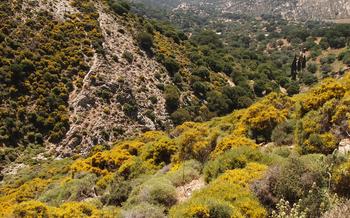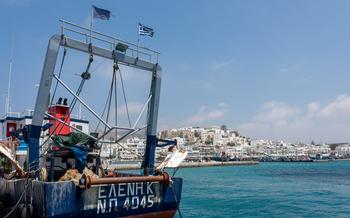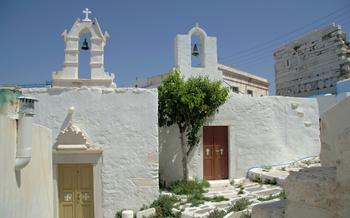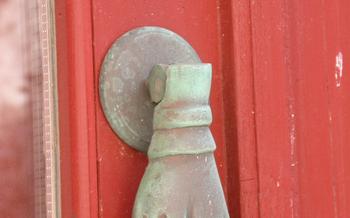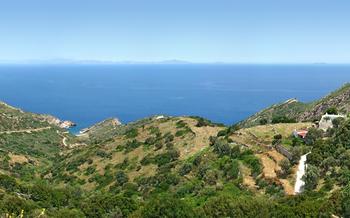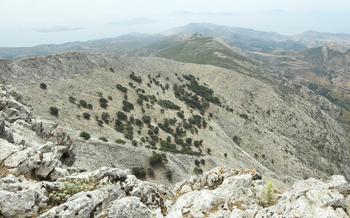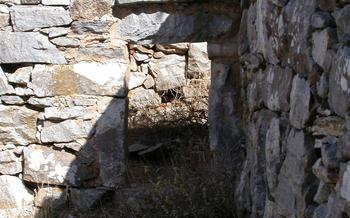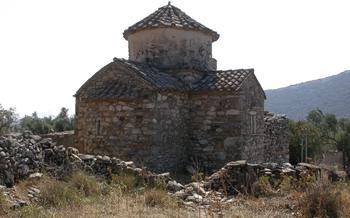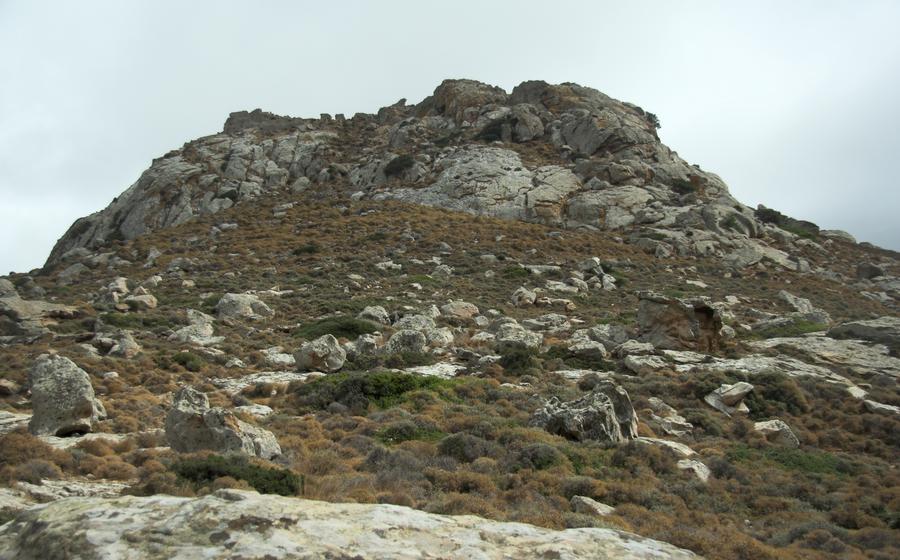
Naxos Castle (Kastro)
- The History of Naxos Castle (Kastro)
- The Architecture of Naxos Castle (Kastro)
- The Layout of Naxos Castle (Kastro)
- The Views from Naxos Castle (Kastro)
- Things to Do at Naxos Castle (Kastro)
- The Cost of Visiting Naxos Castle (Kastro)
- The Hours of Operation of Naxos Castle (Kastro)
- The Location of Naxos Castle (Kastro)
- Restaurants and Cafes near Naxos Castle (Kastro)
- Souvenirs and Gifts Available at Naxos Castle (Kastro)
- The Photography Opportunities at Naxos Castle (Kastro)
- History of the Naxos Castle (Kastro) Museum
- The Things to Do at the Naxos Castle (Kastro) Museum
- Insider Tip:
The History of Naxos Castle (Kastro)
Naxos Castle, also known as Kastro, is a historical fortress located in the heart of Naxos Town, the capital of the Greek island of Naxos. The castle's origins date back to the 13th century when the Venetian Republic, which had control over the island at the time, began its construction. The Venetians sought to establish a stronghold on the island to protect their trade routes and assert their dominance in the Aegean Sea.
The castle's construction spanned several decades, and it was completed in the 16th century. During this period, Naxos Castle served as the administrative center of the Venetian duchy of Naxos, which included the entire Cyclades island group. The castle was designed to withstand attacks from both land and sea, featuring thick walls, towers, and a moat.
Throughout history, Naxos Castle has played a significant role in the island's history. It has been besieged and captured by various forces, including the Ottomans, who ruled Naxos for over two centuries. The castle's strategic location and defensive capabilities made it a crucial stronghold for controlling the island.
After Greece gained independence in the 19th century, Naxos Castle gradually lost its military significance. It was repurposed for various uses, including as a prison, a school, and a cultural center. Today, the castle stands as a testament to Naxos' rich history and is a popular tourist attraction, offering visitors a glimpse into the island's Venetian past.
The Architecture of Naxos Castle (Kastro)
The architectural style of Naxos Castle is a mix of Byzantine and Venetian influences. The castle was built using local stone and marble. The walls are thick and crenellated, and the towers are round. The castle is entered through a large gate, which is flanked by two towers. The most interesting architectural features of the castle include the Venetian coat of arms above the gate, the Byzantine frescoes in the chapel, and the large cistern in the courtyard. The castle's architecture has changed over time, with the addition of new towers and walls in the 16th and 17th centuries.
The Layout of Naxos Castle (Kastro)
The layout of Naxos Castle (Kastro) is complex and fascinating. The castle is divided into two main parts: the outer bailey and the inner bailey. The outer bailey is surrounded by a massive wall, which is punctuated by several towers. The inner bailey is located on a higher level and is protected by another wall.
The outer bailey contains several important buildings, including the church of Agios Georgios Diasoritis, the Venetian Arsenal, and the Governor's Palace. The inner bailey contains the remains of the Ducal Palace, the Catholic Cathedral, and several other important buildings.
The different parts of the castle are connected by a series of narrow streets and staircases. The layout of the castle is designed to make it easy to defend, and it has been used successfully to repel several attacks over the centuries.
The layout of Naxos Castle (Kastro) has changed over time. The original castle was built in the 13th century, and it has been modified and expanded several times since then. The most significant changes were made in the 16th century, when the Venetians rebuilt the castle after it was destroyed by an earthquake.
The Views from Naxos Castle (Kastro)
The views from Naxos Castle (Kastro) are simply breathtaking, offering a panoramic vista that encompasses the entire island and beyond. From the castle's ramparts, visitors can gaze out over the sparkling Aegean Sea, taking in the picturesque harbor, the lush green valleys, and the rugged mountain peaks that form the backdrop of this enchanting island.
On a clear day, the visibility from the castle is remarkable. The neighboring islands of Paros, Antiparos, and Ios can be seen rising from the sea like distant jewels, their whitewashed villages gleaming in the sunlight. The vast expanse of the Aegean Sea stretches out before you, with its shimmering turquoise waters and gentle waves lapping at the shores of Naxos.
The views from the castle change dramatically depending on the time of day and year. At sunrise, the sky is painted with vibrant hues of pink, orange, and gold, casting a magical glow over the landscape. As the sun sets, the sky transforms into a canvas of deep reds, purples, and blues, creating a breathtaking spectacle that is not to be missed.
In the spring, the island is awash with color as wildflowers bloom in abundance, carpeting the hillsides with vibrant hues of red, yellow, and purple. The air is filled with the sweet fragrance of jasmine and orange blossoms, creating a heady perfume that lingers in the air.
Summer brings with it a different kind of beauty, as the island basks in the warm Mediterranean sun. The sea becomes a deep, azure blue, and the beaches are alive with the sound of laughter and the splash of waves. From the castle, visitors can enjoy stunning views of the coastline, with its secluded coves, sandy beaches, and crystal-clear waters.
As autumn approaches, the colors of the landscape begin to change once again. The leaves of the trees turn golden brown, and the vineyards take on a deep burgundy hue. The air becomes crisp and cool, and the sunsets become even more spectacular, with the sky ablaze with fiery colors.
Winter brings a sense of tranquility to the island, and the views from the castle become even more serene. The sea takes on a deep, dark blue color, and the snow-capped mountains in the distance create a stunning contrast to the clear blue sky. The castle itself becomes a winter wonderland, with its whitewashed walls and towers standing out against the backdrop of the snowy landscape.
Things to Do at Naxos Castle (Kastro)
Naxos Castle (Kastro) offers a variety of activities and attractions for visitors to enjoy.
-
Explore the Castle's Interior: Embark on a journey through time as you wander through the castle's well-preserved interior. Discover secret passages, grand halls, and hidden chambers that tell the story of the castle's rich history.
-
Take a Guided Tour: Enhance your visit by joining a guided tour led by knowledgeable local experts. These tours provide fascinating insights into the castle's history, architecture, and significance, bringing its stories to life.
-
Attend Events and Activities: Naxos Castle (Kastro) hosts a variety of events and activities throughout the year. From cultural exhibitions and art shows to medieval festivals and concerts, there's always something exciting happening at the castle. Check the castle's official website or local tourism guides for upcoming events.
-
Enjoy Panoramic Views: Ascend to the castle's highest point and be rewarded with breathtaking panoramic views of Naxos Town, the Aegean Sea, and the surrounding islands. Capture stunning photos and create lasting memories of your visit.
-
Relax and Unwind: Find a secluded spot within the castle walls and soak in the tranquil atmosphere. Whether you prefer to read a book, meditate, or simply enjoy the peace and quiet, the castle offers an ideal retreat from the bustling town below.
The Cost of Visiting Naxos Castle (Kastro)
Visiting Naxos Castle is free of charge, making it an accessible and affordable attraction for travelers of all budgets. There are no admission fees, guided tour fees, or parking fees to worry about.
However, if you wish to embark on a more immersive experience, guided tours are available at an additional cost. These tours typically range from €10 to €20 per person and offer insights into the castle's history, architecture, and significance.
To save money on your visit, consider exploring the castle independently and taking advantage of the free resources available online. Many websites and guidebooks provide detailed information and self-guided tours that allow you to learn about the castle's history and admire its features at your own pace.
For those seeking a comprehensive experience, consider combining your visit to Naxos Castle with other attractions on the island. The Naxos Archaeological Museum, located in the heart of Naxos Town, offers a glimpse into the island's rich history and culture. Admission to the museum costs €6 for adults and €3 for students and seniors.
By planning your visit and taking advantage of the available resources, you can enjoy Naxos Castle and other attractions on the island without breaking the bank.
The Hours of Operation of Naxos Castle (Kastro)
The Naxos Castle (Kastro) is open to the public daily from 8:00 am to 8:00 pm. However, it is important to note that the castle may be closed on certain days or times due to special events or inclement weather. It is always a good idea to check the castle's official website or contact the local tourist office for the most up-to-date information on hours of operation.
During the off-season, the castle may have reduced hours of operation or may be closed altogether. It is important to plan your visit accordingly if you are traveling during this time.
To avoid crowds, it is best to visit the castle early in the morning or late in the afternoon. The castle is also typically less crowded during the weekdays than on the weekends.
The Location of Naxos Castle (Kastro)
Naxos Castle (Kastro) is majestically situated on a small islet just off the coast of Naxos Town, the island's capital. This strategic location, separated from the mainland by a narrow channel, has played a crucial role in the castle's history, providing both defense and control over the island's main port.
How to Get to the Castle:
-
On Foot: A charming footbridge, known as the causeway, connects the islet to the mainland, offering a picturesque and convenient way to reach the castle.
-
By Boat: For a unique and unforgettable experience, visitors can opt to take a short boat ride from Naxos Town to the castle, enjoying the stunning coastal views along the way.
Parking:
Limited parking is available in the vicinity of the castle, particularly during the off-season. However, it is advisable to plan your visit accordingly and consider alternative transportation options to avoid congestion.
Public Transportation:
Naxos Town is well-connected by public transportation, including buses and taxis. From the town center, visitors can easily catch a bus or taxi to the castle, making it an accessible destination for all.
Restaurants and Cafes near Naxos Castle (Kastro)
There are a number of restaurants and cafes located near Naxos Castle (Kastro), offering a variety of dining options for visitors. Some of the most popular restaurants include:
-
To Kastro: A traditional Greek tavern serving a variety of dishes, including fresh seafood, grilled meats, and vegetarian options.
-
O Gyros tis Paralias: A popular spot for gyros, a traditional Greek dish made with grilled meat wrapped in pita bread.
-
To Steki tou Ilia: A family-run restaurant serving home-cooked Greek food, including moussaka, pastitsio, and souvlaki.
-
Cafe Meltemi: A charming cafe offering a variety of coffees, teas, and light snacks.
-
Gelateria Italiana: A popular spot for ice cream, with a variety of flavors to choose from.
Most of the restaurants and cafes near Naxos Castle (Kastro) are open year-round, although some may have shorter hours during the off-season. Prices vary depending on the restaurant and the type of food, but you can expect to pay around €10-€20 for a main course.
Whether you're looking for a quick bite to eat or a leisurely meal, you're sure to find something to your liking at one of the many restaurants and cafes located near Naxos Castle (Kastro).
Souvenirs and Gifts Available at Naxos Castle (Kastro)
The Castle of Naxos offers a variety of souvenir shops where visitors can purchase a range of items to commemorate their visit to this historic site. These shops sell a wide array of traditional Greek souvenirs, including hand-painted ceramics, woven textiles, and jewelry made with local materials. Visitors can also find replicas of ancient artifacts, such as coins, pottery, and statues, as well as books and postcards featuring images of the castle and the surrounding area.
The souvenirs available at the Castle of Naxos are reasonably priced and make for excellent gifts for friends and family back home. Whether you are looking for a unique piece of jewelry, a handcrafted souvenir, or simply a postcard to send to loved ones, you are sure to find something to your liking at the castle's souvenir shops.
The Photography Opportunities at Naxos Castle (Kastro)
The Naxos Castle (Kastro) offers a wealth of photography opportunities, with its panoramic views, ancient architecture, and picturesque surroundings. Whether you're a professional photographer or simply looking to capture some stunning vacation photos, the castle is a must-visit destination. Here are a few tips for making the most of your photography experience at Naxos Castle (Kastro):
-
Best Places to Take Photos: The top of the castle offers breathtaking views of the Aegean Sea, the surrounding islands, and the mainland of Greece. The courtyard of the castle is also a great place to take photos, with its intricate architecture and lush gardens.
-
Best Time of Day: The golden hours of sunrise and sunset are the best times to take photos at the castle, as the warm light casts a magical glow on the ancient stone walls. However, the castle is also beautiful at night, when it is illuminated and provides a stunning backdrop for your photos.
-
Photography Tours and Workshops: If you're serious about your photography, consider joining a photography tour or workshop at the castle. These tours and workshops are led by professional photographers who can teach you the best techniques for capturing the castle's beauty.
Remember, the best way to capture the essence of Naxos Castle (Kastro) is to experiment and have fun with your photography. Don't be afraid to try different angles, compositions, and settings to find the perfect shot.
History of the Naxos Castle (Kastro) Museum
The Naxos Castle (Kastro) Museum was founded in 1933 by the Archaeological Society of Athens. The purpose of the museum is to preserve and display the history of the castle and the island of Naxos. The museum houses a collection of artifacts from the castle and the surrounding area, including pottery, sculptures, coins, and tools. Some of the most interesting exhibits in the museum include a collection of ancient maps of Naxos, a model of the castle, and a replica of a Venetian ship. The museum has changed over time to include more exhibits and to provide visitors with a more comprehensive understanding of the castle and the history of Naxos.
The Things to Do at the Naxos Castle (Kastro) Museum
The Naxos Castle (Kastro) Museum is a must-visit for anyone interested in the history and culture of Naxos. The museum houses a collection of artifacts from the castle and the surrounding area, including pottery, jewelry, and sculptures. There are also exhibits on the history of the castle and the island of Naxos.
Visitors to the museum can learn about the different cultures that have inhabited Naxos over the centuries, from the ancient Greeks to the Venetians to the Ottomans. The museum also has a section on the island's natural history, including its flora and fauna.
The Naxos Castle (Kastro) Museum is a great place to learn about the history and culture of Naxos. It is a must-visit for anyone who wants to get a deeper understanding of this beautiful island.
Guided tours of the museum are available in English and Greek.
The museum is open from 9am to 5pm, Tuesday to Sunday.
Admission is free.
Insider Tip:
To fully embrace the magic of Naxos Castle, plan your visit during the enchanting evening hours. As the sun gracefully bows out, the castle transforms under a blanket of golden light, casting an ethereal glow upon its ancient walls. With fewer crowds and a serene atmosphere, you can bask in the tranquility and truly connect with the castle's rich history. Capture the essence of this special moment by packing a camera and tripod to immortalize the castle's captivating beauty against the backdrop of a star-studded sky.
